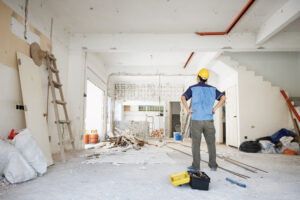The main purpose of renovations is to increase the value of a property. Adding new fixtures and upgrading existing ones are ways to do this. Visit Retaining Walls Perth for more information about renovation.
It’s important to stay within a budget when doing renovations. The most common reason that renovations go over budget is due to changes once the work begins.

Many renovations are designed to increase a home’s value, making it more appealing to potential buyers. These improvements can be cosmetic or structural and may include:
- Adding new features to a kitchen or bathroom.
- Finishing a basement.
- Putting on a new roof.
Other renovations are designed to make a home more energy-efficient or green, which can also boost its value. Moreover, homeowners’ tastes and needs change over time, so renovations may be done better to match a house with its owner’s lifestyle or add more functionality to the living space.
The exact percentage of value an improvement adds depends on the renovation’s timing, the work’s quality, and how it compares with similar homes in the neighborhood. For example, a pool may add less value to a home in a colder climate where the cost of heating and maintaining it could outweigh the benefit in terms of added home value. Additionally, certain types of improvements will last longer than others. For instance, building an addition will last longer than installing a new air conditioning unit, which will likely be outdated within a few years.
In general, exterior and outdoor improvements impact a property’s value most. Projects like garage door replacement and wood deck additions can significantly increase the value of a home, while interior changes have a more limited effect on home values. Energy-efficient enhancements are a top-value driver, as they can lower utility bills and help reduce carbon emissions.
However, not every renovation makes a profit. Some may even decrease a home’s value. For example, overly personalized or highly detailed remodels may turn off some potential buyers. Other projects, such as an oversized pool or a kitchen that is excessively expensive and out of alignment with the local market, can make it difficult to sell a home for a good price.
Energy-efficient renovations increase the performance of building structures, resulting in reduced energy consumption and lower operating costs. This is possible by incorporating high-performance insulation materials, efficient heating and cooling systems, and well-sealed windows and doors. In addition to reducing energy costs, these changes can improve thermal comfort and indoor air quality.
Despite the economic potential of energy efficiency measures, installation rates remain low. This is largely because formal models of renovation decision-making – including those used in applied behavioral research on energy-efficient behavior – largely ignore the wide range of personal and contextual influences on investing in energy efficiency improvements. This is a significant shortcoming, as understanding the reasons for and barriers to investment in efficiency improvements can help shape policy interventions to overcome these obstacles.
In addition to financial benefits, owners invest in energy efficiency measures for various other reasons. These include:
Improved living and building conditions: The most significant motivating driver identified in the study was enhanced thermal and indoor comfort. This is because owners value having adequate comfort levels to live and work in their homes, which can be achieved by installing energy-efficient insulation and efficient heating and cooling systems. Owners also value co-benefits such as reduced draughts and condensation, better indoor air quality, and the ability to rent their properties at a higher price.
Sense of obligation: The impact of the recent spike in energy prices may have increased owners’ awareness of their energy consumption levels and the need to take steps to reduce them. This, combined with the desire to maximize resale values and minimize technical problems and complaints, motivated many owners to improve energy efficiency.
It is important to hire a contractor for any renovation project. This will ensure that the work is done correctly and professionally. Look for a contractor who has experience and good references. In addition, consider getting quotes from multiple contractors so that you can compare prices and services. This will help you find the best contractor for your needs.
One of the most important reasons for renovation is to improve a building’s aesthetics. A well-planned and executed project can increase the appeal of a property and even attract new customers. However, homeowners should always be aware of how their renovations will affect the neighborhood and choose projects carefully to avoid over-improving the home. For instance, if your neighborhood is full of homes with in-ground pools, installing an above-ground pool will probably decrease the value of your house. Improvements that are too personalized and out of line with the style of other homes in the neighborhood are also likely to detract from the property’s value.
There are many different ways to renovate a house. Some are more cost-effective than others, but the return on investment (ROI) will depend on the local market and the residential real estate market state when the house is sold. Historically, home improvements such as adding a wood deck, kitchen and bathroom upgrades, and window replacement have shown the greatest ROI.
Other improvements have a more limited impact on resale value, such as swimming pools, wallpaper or bold colors, and elaborate landscaping projects. These improvements can be more costly, and they may turn off potential buyers with other priorities or looking for a specific type of property.
If you’re considering a renovation project, consult a professional to ensure the work will be done correctly and safely. It’s also a good idea to consider the renovation’s impact on the neighborhood and check whether any legal requirements need to be met. If you’re not licensed or insured, it could be illegal to do the work yourself, and you might be liable for any accidents during the process. Finally, remember that renovations can significantly impact your property tax assessment. Contact your local city or county government if you need clarification on what your property tax assessment will be. They’ll be able to tell you what your property’s current value is and will be able to help you determine the right renovations to make.
Full renovations are a major overhaul of the home area and usually involve changing everything from walls to fixtures. This process can be time-consuming and costly but is necessary to keep up with modern trends and meet the homeowner’s vision. There are several ways to renovate, including repairing, painting, or varnishing wooden surfaces, installing new floor coverings and tiling, and installing systems utilities like ACs and furnaces.
Renovations can also involve restoring the original features of a building and preserving its heritage and rich culture. This is especially important for historical buildings and involves altering surfaces while retaining the appearance of the original structure. This process can be more expensive and complicated than other renovations, but it is often less disruptive to daily life.
Situated approaches to energy-efficient renovation decision-making highlight the importance of understanding why and when householders choose to renovate. They reveal that the reasons for renovating are complex and multifaceted and that decisions to renovate are shaped by and emerge within the conditions of everyday domestic life.
For example, household members may cite aesthetics and thermal comfort as important motivations for renovating before the renovation takes place, but they will retrospectively emphasize savings and energy efficiency [87]. This post hoc rationalization reveals that it is difficult to incorporate non-monetary motives into behaviourally informed policies to encourage energy-efficient renovation. This is a key challenge in the research on residential energy efficiency and may explain why many interventions aimed at increasing energy-efficient renovation have failed to reduce energy demand or generate savings [89]. A broader perspective on renovation decision influences, which considers how homeowners think about their homes, may help improve the effectiveness of policies and measures promoting energy-efficient renovation.

